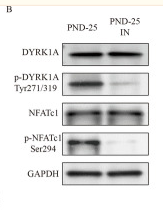Phospho-DYRK1A/B (Tyr319/Tyr271) Antibody - #AF3507
| Product: | Phospho-DYRK1A/B (Tyr319/Tyr271) Antibody |
| Catalog: | AF3507 |
| Description: | Rabbit polyclonal antibody to Phospho-DYRK1A/B (Tyr319/Tyr271) |
| Application: | IHC IF/ICC |
| Cited expt.: | |
| Reactivity: | Human, Mouse, Rat |
| Mol.Wt.: | 86kD,69kD(Calculated). |
| Uniprot: | Q13627 | Q9Y463 |
| RRID: | AB_2846821 |
Product Info
*The optimal dilutions should be determined by the end user. For optimal experimental results, antibody reuse is not recommended.
*Tips:
WB: For western blot detection of denatured protein samples. IHC: For immunohistochemical detection of paraffin sections (IHC-p) or frozen sections (IHC-f) of tissue samples. IF/ICC: For immunofluorescence detection of cell samples. ELISA(peptide): For ELISA detection of antigenic peptide.
Cite Format: Affinity Biosciences Cat# AF3507, RRID:AB_2846821.
Fold/Unfold
Dual specificity tyrosine phosphorylation regulated kinase; Dual specificity tyrosine (Y) phosphorylation regulated kinase 1A; Dual specificity tyrosine phosphorylation regulated kinase 1; Dual specificity tyrosine phosphorylation regulated kinase 1A; Dual specificity tyrosine-phosphorylation-regulated kinase 1A; Dual specificity YAK 1 related kinase; Dual specificity YAK1 related kinase; Dual specificity YAK1-related kinase; DYR1A_HUMAN; DYRK 1; DYRK 1A; DYRK; DYRK1; Dyrk1a; DYRKA; hMNB; HP 86; HP86; Minibrain (Drosophila) homolog; Minibrain homolog; Minibrain, Drosophila, homolog of; MNB; MNB protein kinase; Mnb protein kinase homolog hp86; MNB protein kinase, Serine/threonine-specific; MNB/DYRK protein kinase; MNBH; MRD7; OTTHUMP00000109090; OTTHUMP00000109091; OTTHUMP00000109094; OTTHUMP00000174799; Protein kinase minibrain homolog; Serine/threonine kinase MNB; AOMS3; Dual specificity tyrosine (Y) phosphorylation regulated kinase 1B; Dual specificity tyrosine phosphorylation regulated kinase 1B; Dual spec
Immunogens
A synthesized peptide derived from human DYRK1A/B around the phosphorylation site of Tyr319/271.
Ubiquitous. Highest levels in skeletal muscle, testis, fetal lung and fetal kidney.
Q9Y463 DYR1B_HUMAN:Highest expression in skeletal muscle, testis, heart and brain with little expression in colon or lung. Expressed in a variety of tumor cell lines.
- Q13627 DYR1A_HUMAN:
- Protein BLAST With
- NCBI/
- ExPASy/
- Uniprot
MHTGGETSACKPSSVRLAPSFSFHAAGLQMAGQMPHSHQYSDRRQPNISDQQVSALSYSDQIQQPLTNQVMPDIVMLQRRMPQTFRDPATAPLRKLSVDLIKTYKHINEVYYAKKKRRHQQGQGDDSSHKKERKVYNDGYDDDNYDYIVKNGEKWMDRYEIDSLIGKGSFGQVVKAYDRVEQEWVAIKIIKNKKAFLNQAQIEVRLLELMNKHDTEMKYYIVHLKRHFMFRNHLCLVFEMLSYNLYDLLRNTNFRGVSLNLTRKFAQQMCTALLFLATPELSIIHCDLKPENILLCNPKRSAIKIVDFGSSCQLGQRIYQYIQSRFYRSPEVLLGMPYDLAIDMWSLGCILVEMHTGEPLFSGANEVDQMNKIVEVLGIPPAHILDQAPKARKFFEKLPDGTWNLKKTKDGKREYKPPGTRKLHNILGVETGGPGGRRAGESGHTVADYLKFKDLILRMLDYDPKTRIQPYYALQHSFFKKTADEGTNTSNSVSTSPAMEQSQSSGTTSSTSSSSGGSSGTSNSGRARSDPTHQHRHSGGHFTAAVQAMDCETHSPQVRQQFPAPLGWSGTEAPTQVTVETHPVQETTFHVAPQQNALHHHHGNSSHHHHHHHHHHHHHGQQALGNRTRPRVYNSPTNSSSTQDSMEVGHSHHSMTSLSSSTTSSSTSSSSTGNQGNQAYQNRPVAANTLDFGQNGAMDVNLTVYSNPRQETGIAGHPTYQFSANTGPAHYMTEGHLTMRQGADREESPMTGVCVQQSPVASS
- Q9Y463 DYR1B_HUMAN:
- Protein BLAST With
- NCBI/
- ExPASy/
- Uniprot
MAVPPGHGPFSGFPGPQEHTQVLPDVRLLPRRLPLAFRDATSAPLRKLSVDLIKTYKHINEVYYAKKKRRAQQAPPQDSSNKKEKKVLNHGYDDDNHDYIVRSGERWLERYEIDSLIGKGSFGQVVKAYDHQTQELVAIKIIKNKKAFLNQAQIELRLLELMNQHDTEMKYYIVHLKRHFMFRNHLCLVFELLSYNLYDLLRNTHFRGVSLNLTRKLAQQLCTALLFLATPELSIIHCDLKPENILLCNPKRSAIKIVDFGSSCQLGQRIYQYIQSRFYRSPEVLLGTPYDLAIDMWSLGCILVEMHTGEPLFSGSNEVDQMNRIVEVLGIPPAAMLDQAPKARKYFERLPGGGWTLRRTKELRKDYQGPGTRRLQEVLGVQTGGPGGRRAGEPGHSPADYLRFQDLVLRMLEYEPAARISPLGALQHGFFRRTADEATNTGPAGSSASTSPAPLDTCPSSSTASSISSSGGSSGSSSDNRTYRYSNRYCGGPGPPITDCEMNSPQVPPSQPLRPWAGGDVPHKTHQAPASASSLPGTGAQLPPQPRYLGRPPSPTSPPPPELMDVSLVGGPADCSPPHPAPAPQHPAASALRTRMTGGRPPLPPPDDPATLGPHLGLRGVPQSTAASS
Research Backgrounds
Dual-specificity kinase which possesses both serine/threonine and tyrosine kinase activities. May play a role in a signaling pathway regulating nuclear functions of cell proliferation. Modulates alternative splicing by phosphorylating the splice factor SRSF6 (By similarity). Exhibits a substrate preference for proline at position P+1 and arginine at position P-3. Has pro-survival function and negatively regulates the apoptotic process. Promotes cell survival upon genotoxic stress through phosphorylation of SIRT1. This in turn inhibits TP53 activity and apoptosis (By similarity).
Autophosphorylated on numerous tyrosine residues. Can also autophosphorylate on serine and threonine residues (in vitro).
Nucleus. Nucleus speckle.
Ubiquitous. Highest levels in skeletal muscle, testis, fetal lung and fetal kidney.
The polyhistidine repeats act as targeting signals to nuclear speckles.
Belongs to the protein kinase superfamily. CMGC Ser/Thr protein kinase family. MNB/DYRK subfamily.
Dual-specificity kinase which possesses both serine/threonine and tyrosine kinase activities. Enhances the transcriptional activity of TCF1/HNF1A and FOXO1. Inhibits epithelial cell migration. Mediates colon carcinoma cell survival in mitogen-poor environments. Inhibits the SHH and WNT1 pathways, thereby enhancing adipogenesis. In addition, promotes expression of the gluconeogenic enzyme glucose-6-phosphatase (G6PC).
Autophosphorylated on tyrosine residues. Phosphorylated by MAP kinase. Tyrosine phosphorylation may be required for dimerization.
Nucleus.
Highest expression in skeletal muscle, testis, heart and brain with little expression in colon or lung. Expressed in a variety of tumor cell lines.
Belongs to the protein kinase superfamily. CMGC Ser/Thr protein kinase family. MNB/DYRK subfamily.
References
Application: WB Species: Rat Sample:
Restrictive clause
Affinity Biosciences tests all products strictly. Citations are provided as a resource for additional applications that have not been validated by Affinity Biosciences. Please choose the appropriate format for each application and consult Materials and Methods sections for additional details about the use of any product in these publications.
For Research Use Only.
Not for use in diagnostic or therapeutic procedures. Not for resale. Not for distribution without written consent. Affinity Biosciences will not be held responsible for patent infringement or other violations that may occur with the use of our products. Affinity Biosciences, Affinity Biosciences Logo and all other trademarks are the property of Affinity Biosciences LTD.


